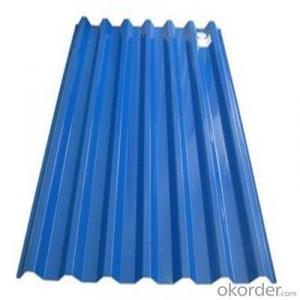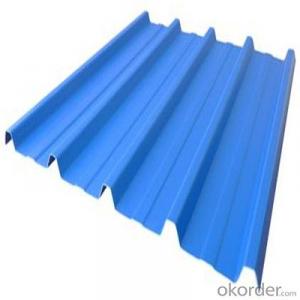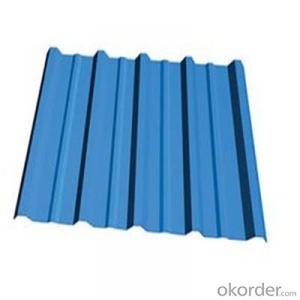Prepaint Galvanized Corrugated Iron Sheets
- Loading Port:
- Tianjin
- Payment Terms:
- TT OR LC
- Min Order Qty:
- 100 m.t.
- Supply Capability:
- 1000345 m.t./month
OKorder Service Pledge
OKorder Financial Service
You Might Also Like
Item specifice
Description of Corrugated Iron Sheet:
Minimum yield strength of 550 MPa ensures required strength for roofing application
Accurate thickness, width and length gives a perfect fit for any roof
Wider valley ensures higher water discharge in case of heavy rains
Specifications of Corrugated Iron Sheet:
Material | Steel |
Color | All RAL color |
Thickness | 0.23-1.0MM |
Width | 600mm to1200mm |
Zinc coating | 80 to 275g m2 |
Certificate | ISO 9001:2000 |
Minimum Order Quantity: | 300 Square Meter/Square Meters |
Packaging Details: | plastic film and in bundles |
Delivery Time: | within 15 days |
Supply Ability: | 30,000 Square Meter/Square Meters per day |
Features of Corrugated Iron Sheet:
Raw material width 762mm, after corrugated width 665mm: 9 waves.
Raw material width 914mm ,after corrugated width 800mm:11 waves.
Raw material width 1000mm, after corrugated 890mm or 900mm :12 or 14 waves. as customer requirement
Images of Corrugated Iron Sheet:

FAQ:
1. What's the Delivery port?
The main ports are Qingdao and Tianjin, we also can deliver to other ports to meet your requirements
2. How long is the lead time?
Delivery time: 45 days after order confirmed.
3. What payment term do you accept?
Payment: T/T or L/C at sight.
- Q:What are the most common thicknesses of steel sheets?
- Steel sheets come in various thicknesses, which are determined by their intended use and industry standards. Examples of commonly used thicknesses include 20 gauge (0.035 inches), 18 gauge (0.0478 inches), 16 gauge (0.0598 inches), 14 gauge (0.0747 inches), and 10 gauge (0.1046 inches). These thicknesses are commonly employed in sectors like construction, automotive, and manufacturing. In certain cases, thinner gauges like 24 gauge (0.0239 inches) and 22 gauge (0.0299 inches) may be utilized for lighter applications or when weight reduction is a priority. Ultimately, the chosen thickness will depend on the specific project requirements and the desired structural integrity.
- Q:Can steel sheets be used for making HVAC ducts?
- Yes, steel sheets can be used for making HVAC (Heating, Ventilation, and Air Conditioning) ducts. Steel is a commonly used material for HVAC duct fabrication due to its strength, durability, and fire resistance properties. Steel sheets are typically cut, formed, and welded together to create ductwork that can efficiently transport air throughout a building. The use of steel sheets ensures that the ducts can withstand the high temperatures and pressures associated with HVAC systems while maintaining structural integrity. Additionally, steel ducts are less prone to damage from pests, moisture, and mold growth compared to other materials. Overall, steel sheets are a suitable choice for making HVAC ducts due to their reliability and ability to meet the necessary performance requirements.
- Q:What is the typical hardness range for steel sheets?
- The hardness range of steel sheets varies depending on the specific grade and type of steel employed. Generally, steel sheets exhibit a hardness range of 150 to 250 on the Vickers hardness scale (HV), striking a favorable balance between strength and formability. This characteristic renders steel sheets appropriate for a diverse array of applications. It is worth emphasizing that the hardness can be further modified through different heat treatment methods to attain desired properties.
- Q:What are the different types of surface finishes available for steel sheets?
- Some different types of surface finishes available for steel sheets include hot rolled, cold rolled, galvanized, and coated finishes.
- Q:What are the different grades of steel sheets available?
- There exists a variety of steel sheet grades, each possessing its own distinctive properties and applications. Among the commonly utilized grades are: 1. Carbon Steel: This grade of steel sheet is the most prevalent and extensively employed. It comprises varying carbon levels and is renowned for its robustness and durability. Carbon steel sheets find utility across diverse sectors, including construction, automotive, and manufacturing. 2. Stainless Steel: Distinguished by its elevated chromium content, this steel sheet grade showcases outstanding resistance to corrosion. Industries such as food processing, chemical, and medical frequently employ stainless steel sheets where corrosion resistance plays a pivotal role. 3. Galvanized Steel: To shield against corrosion, this type of steel sheet is coated with a layer of zinc. Galvanized steel sheets often serve in outdoor settings, such as roofing, fences, and gutters, where exposure to moisture and the elements is commonplace. 4. Alloy Steel: By incorporating additional elements like manganese, nickel, or chromium, this grade of steel sheet enhances its mechanical properties. Alloy steel sheets are extensively used in applications demanding heightened strength, such as construction equipment, aircraft components, and machinery. 5. Tool Steel: Designed with elevated hardness and wear resistance, this grade of steel sheet is ideal for tools and dies. Industries such as automotive, aerospace, and manufacturing frequently employ tool steel sheets. It's crucial to note that these represent only a fraction of the available steel sheet grades, as numerous specialized grades are tailored to specific applications. The choice of grade depends on factors such as desired strength, corrosion resistance, and specific application requirements.
- Q:Can steel sheets be used for solar panel support structures?
- Yes, steel sheets can be used for solar panel support structures. Steel is a strong and durable material that can provide the necessary structural support for solar panels. It is widely used in the construction industry due to its high strength-to-weight ratio and resistance to corrosion, making it suitable for outdoor applications such as solar panel installations.
- Q:What is the process of annealing steel sheets?
- Annealing steel sheets is a heat treatment process that involves heating the steel sheets to a specific temperature and then slowly cooling them to soften the material and relieve internal stresses. This process helps improve the steel's ductility, machinability, and overall mechanical properties.
- Q:Can steel sheets be used for fire-rated doors?
- Yes, steel sheets can be used for fire-rated doors. In fact, steel is one of the most commonly used materials for fire-rated doors due to its high strength, durability, and fire-resistance properties. Steel sheets used in fire-rated doors are typically constructed with multiple layers of fire-resistant material, such as gypsum or mineral core, sandwiched between the steel sheets. This construction helps to prevent the spread of fire and smoke, providing a reliable barrier in the event of a fire. Additionally, steel is known for its structural integrity, making it a suitable choice for fire-rated doors that need to withstand high temperatures and pressure.
- Q:Can steel sheets be used for kitchen or food preparation areas?
- Yes, steel sheets can be used for kitchen or food preparation areas. Steel is a durable and hygienic material that is resistant to stains, corrosion, and bacterial growth, making it suitable for use in food-related environments. It is commonly used for countertops, backsplashes, and shelving in commercial kitchens and food processing areas.
- Q:What is the maximum size available for steel sheets?
- The maximum dimensions of steel sheets can differ based on the type and grade of steel used and the manufacturing capabilities of the supplier. Generally, steel sheets can be produced in sizes ranging from small sheets measuring a few inches in width and length, to large sheets measuring several feet or even meters in width and length. The transportation and handling restrictions can also affect the maximum size of steel sheets available, as larger sheets might be harder to transport and manipulate. To determine the maximum size of steel sheets that fit your specific needs, it is advisable to consult with a steel supplier.
1. Manufacturer Overview |
|
|---|---|
| Location | |
| Year Established | |
| Annual Output Value | |
| Main Markets | |
| Company Certifications | |
2. Manufacturer Certificates |
|
|---|---|
| a) Certification Name | |
| Range | |
| Reference | |
| Validity Period | |
3. Manufacturer Capability |
|
|---|---|
| a)Trade Capacity | |
| Nearest Port | |
| Export Percentage | |
| No.of Employees in Trade Department | |
| Language Spoken: | |
| b)Factory Information | |
| Factory Size: | |
| No. of Production Lines | |
| Contract Manufacturing | |
| Product Price Range | |
Send your message to us
Prepaint Galvanized Corrugated Iron Sheets
- Loading Port:
- Tianjin
- Payment Terms:
- TT OR LC
- Min Order Qty:
- 100 m.t.
- Supply Capability:
- 1000345 m.t./month
OKorder Service Pledge
OKorder Financial Service
Similar products
New products
Hot products
Related keywords





























